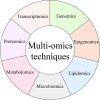Multi-omics insights into bone tissue injury and healing: bridging orthopedic trauma and regenerative medicine
- PMID: 40438296
- PMCID: PMC12118463
- DOI: 10.1093/burnst/tkaf019
Multi-omics insights into bone tissue injury and healing: bridging orthopedic trauma and regenerative medicine
Abstract
To preserve functionality, bone is an active tissue that can constantly reconstruct itself through modeling and remodeling. It plays critical roles in the body, including maintaining mineral homeostasis, serving as the adult human body's core site of hematopoiesis, and supporting the structures of the body's soft tissues. It possesses the natural regeneration capacity, but large and complex lesions often require surgical intervention. Multiple omics integrate proteomics, metabolomics, genomics, and transcriptomics to provide a comprehensive understanding of biological processes like bone tissue injury and healing in bone tissue regeneration and engineering. Recently, bone tissue engineering and regenerative medicines have offered promising tools for bone regeneration using a multi-omics approach. Thus, this article will highlight the role of multiple omics in understanding bone tissue injury and healing. It will discuss the role of bone tissue engineering in developing bone substitutes that can replace translational medicine. Lastly, new developments in bone tissue engineering and regenerative medicine, along with multi-omics approaches, offer promising tools for bone regeneration.
Keywords: Bone tissue healing; Multi-omics; Orthopedic trauma; Regenerative medicine.
© The Author(s) 2025. Published by Oxford University Press.
Conflict of interest statement
None declared.
Figures






Similar articles
-
Spatiotemporal multi-omics: exploring molecular landscapes in aging and regenerative medicine.Mil Med Res. 2024 May 27;11(1):31. doi: 10.1186/s40779-024-00537-4. Mil Med Res. 2024. PMID: 38797843 Free PMC article. Review.
-
Translating Periosteum's Regenerative Power: Insights From Quantitative Analysis of Tissue Genesis With a Periosteum Substitute Implant.Stem Cells Transl Med. 2016 Dec;5(12):1739-1749. doi: 10.5966/sctm.2016-0004. Epub 2016 Jul 27. Stem Cells Transl Med. 2016. PMID: 27465072 Free PMC article.
-
Bone Defect Treatment in Regenerative Medicine: Exploring Natural and Synthetic Bone Substitutes.Int J Mol Sci. 2025 Mar 27;26(7):3085. doi: 10.3390/ijms26073085. Int J Mol Sci. 2025. PMID: 40243725 Free PMC article. Review.
-
Hard tissue regeneration using bone substitutes: an update on innovations in materials.Korean J Intern Med. 2015 May;30(3):279-93. doi: 10.3904/kjim.2015.30.3.279. Epub 2015 Apr 29. Korean J Intern Med. 2015. PMID: 25995658 Free PMC article. Review.
-
Advances in Bone tissue engineering: A fundamental review.J Biosci. 2021;46:17. J Biosci. 2021. PMID: 33737501
Cited by
-
FGFR2 identified as a NETs-associated biomarker and therapeutic target in diabetic foot ulcers.Eur J Med Res. 2025 Aug 13;30(1):748. doi: 10.1186/s40001-025-03012-5. Eur J Med Res. 2025. PMID: 40796870 Free PMC article.
References
Publication types
LinkOut - more resources
Full Text Sources

